It’s hard to know where to start when we’re asked about our favourite Iran highlights. The history here is older than human memory, the landscapes even more ancient, and the people are among the kindest we’ve ever met.
Iran is liberally scattered with places of outstanding cultural, historical, and architectural heritage that are world-renowned and UNESCO-recognised.
Prepare to be delighted by a people that are generous of heart, incredibly warm and welcoming, curious, and rightly proud of their long and epic story.

Iran is a country you discover as much through its beautiful architecture and bustling bazaars as you do through its breathtaking landscapes. A place where tea can take a whole afternoon, and where your preconceptions will be continually challenged and rewritten.
It’s a tall order to try and limit the list of things to do in Iran to a single post, but we’ve made a start here with our round up of 30 places from north, south, central, and western Iran that left an indelible mark.
Whether you plan to travel independently as we did, or you’re searching for an Iran tour, we hope you find our line-up of favourite spots a useful starting point for your own journey of discovery in this ancient, unforgettable land.
Highlights of Tehran
Golestan Palace: Explore a residence fit for kings
Golestan Palace, former palatial residence of the royal Qajar dynasty, is without doubt one of the top things to do in Tehran. Wandering through one of the capital’s oldest and most iconic precincts is a perfect introduction to Iranian arts and architecture.
Located in central Tehran, this beautiful complex lives up to its UNESCO World Heritage billing. Built and restored over the centuries following the Qajar family’s rise to power in the late 1700s, Golestan serves up richly carved archways, ornate tile work, delicate lattice windows, and Persian art galleries set amidst tranquil gardens.
The complex includes a number of halls and pavilions. For us though, the stand-outs were the opulent Takht-e Marmar marble throne terrace, the dazzling mirror hall (no photos allowed, alas), and simply wandering the peaceful gardens with their vibrant, colourful tiled walls.
The nearest metro station to Golestan Palace is Panzdah Khordad and entry cost us around IRR300,000 each. It does close at certain times of the year. Check opening times and prices at the Golestan Palace website.

Imamzadeh Saleh Mosque – Mingle with Locals at this Popular Pilgrimage Site
It’s said that photogenic Imamzadeh Saleh is one of Tehran’s most attractive shrines. But it might just also be one of the friendliest.
We arrived here in time to watch the beautiful patterned turquoise tiles that cover the twin minarets and dome sparkling in the late afternoon sun, just as the marbled square in front of the mosque came to life with Tehrani families gathering to pray and meet friends.
With the imposing Alborz mountain range for a backdrop, this site is a real treat for photographers, especially as the sun sets and the mosque lights up. However it’s the friendly ambience of the complex that we’ll remember the most.
If you settle in to take in the surroundings, you’ll soon be a rewarded, as we were, with a trickle, and then a steady flow of lovely locals keen to say hello and find out what has drawn you to this beautiful sanctuary in the city’s north.
We highly recommend visiting Imamzadeh Saleh in the late afternoon and travelled there by metro to Tajrish station. Don’t miss the dazzling mirrored room. Ladies can borrow a chador at the entrance.
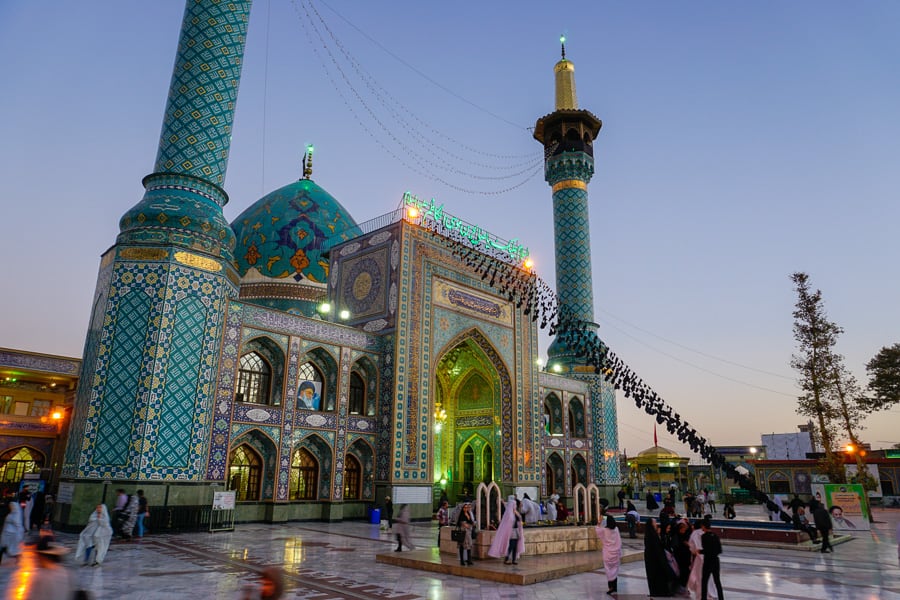
US Den of Espionage: Discover the Intrigue behind the former US Embassy
Anyone interested in US-Iran relations will be intrigued by a visit to the former US Embassy, site of the 1979-80 hostage crisis that lasted more than a year. While a visit might not be for everyone, the building, referred to locally as the US Den of Espionage, provides a window into what is claimed to be the apparatus of US spying activities in Iran.
For some, the free tour of the building might inspire memories of the film Argo. There’s an interesting collection of dated equipment, including encryption machines and shredders, while the colourful collection of murals will leave you in no uncertainty about sentiments surrounding the politics between the US and Iran.
As is often the case in Iran, our tour finished with tea and a chat with our hosts. As we found in many places on our Iran adventure, our discussions ranged broadly across life in Iran and outside, exploring our similarities and our differences.
Darvazeh Dowlat Metro Station is a short walk from the Den. Entry was around IRR200,000 each.
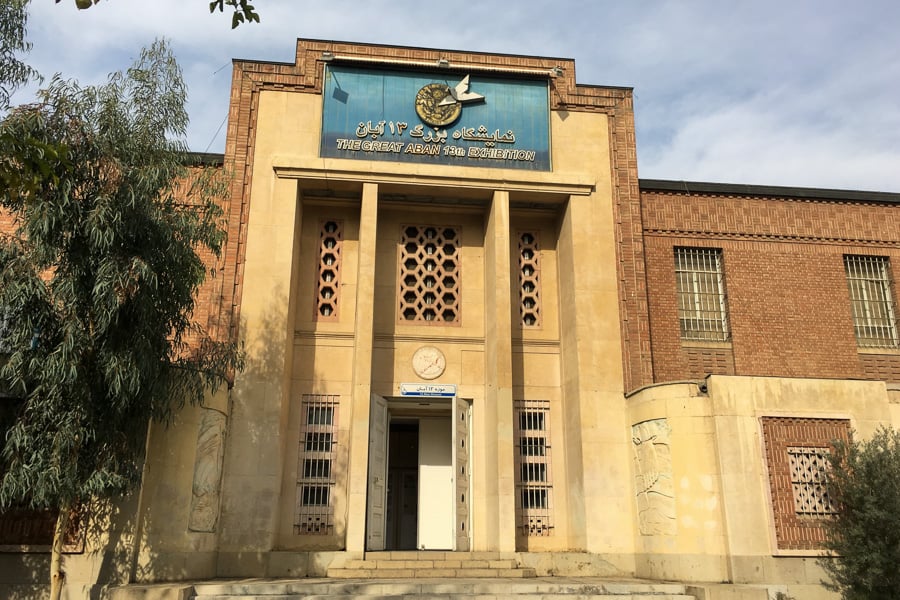
Azadi Tower – Modern Tribute to An Ancient Culture
If you’ve seen pics of Tehran, there’s a fairly strong chance you’ve seen Azadi Tower. It’s one of Iran’s most iconic landmarks, and it goes without saying that you can’t visit Iran without at least one selfie in front of its marble-clad span.
Azadi Tower is a modern ode to Iran’s ancient past: it was created to celebrate the 2,500th anniversary of the first Persian Empire. Impressive from afar, the monument is even more striking up close, with beautiful turquoise tiles decorating the spaces between the marble.
This was our very last stop before leaving Iran, and while we didn’t have a chance to go inside for a peek at the museum underground or to take in the view from the top, it was a perfect finale to our month in this amazing country.
Azadi Tower is quite close to the airport so it makes for an easy first or last stop when you tour Iran. There are a couple of metro stations nearby; Meyran-e Azadi is the closest. It’s free to see the Tower from the square but if you want to go inside, there’s a fee.

Tabiat Bridge: Perfect for Sunset Views Over Tehran
Nothing shows the contemporary face of Iran quite like Tabiat Bridge. Designed by a local architect Leila Araghian, the 270-metre structure is young, vibrant, and modern, just like many of those that wander its very cool spans.
Taking a sunset stroll along the bridge is a great way to get to know Iran’s capital. You’ll meet plenty of locals, both young and old, and have the opportunity to marvel at city skyline and mountain views, all the while being grateful you’re nowhere near the tangled Tehrani traffic jams below.
We’d highly recommend spending an hour or two here to catch the relaxed cosmopolitan vibe, before wandering back to Shahid Haqqani metro station via pretty Taleghani Park. On the way, be sure to keep an eye out for the prettily illuminated Khorramshahr Mosque, a particularly photogenic site once the sun goes down.
If you’re coming from Shahid Haqqani station, wander across Tabiat Bridge and through the collection of restaurants on the other side for a bite if the timing’s right. There’s a skate park down there too that’s worth a stop and a watch.

Northern Iran Highlights
Bazaar of Tabriz – Immerse in the World’s Largest Covered Bazaar
One of the absolute highlights of Iran, and another of the country’s many UNESCO sites, this thousand-year-old Silk Road bazaar is a joy to get lost in.
And get lost you will. With more than 5,500 shops and around seven kilometres of beautifully vaulted caravanserai, interconnected through a tangle of passageways, the Bazar-e Tabriz is the world’s largest covered marketplace. It’s also one of the oldest.
While it would probably take days to see the whole thing, we made do with wandering the colourful spice markets and taking in exquisite Persian carpets at the dedicated carpet trading section, the ‘mozaffareih’, with its beautiful patterned brick ceilings.
Tabriz Bazaar is in the heart of Tabriz in East Azrbaijan Province. It’s open from early till late every day but Friday.
Bonus Food Highlight: Keep an eye out near the entrance of Tabriz Bazaar for guys cooking up a local street food specialty called Yeralma Yumurta: it’s potato and egg mashed together with salt, pepper and butter and wrapped in lavosh. Sooooo good (and less than a dollar for a filling snack)!

Blue Mosque, Tabriz: Glimpse A Past Splendour
We can only imagine how dazzling the Blue Mosque of Tabriz must have been in its heyday, before an 18th century earthquake devastated the intricate blue majolica tilework that once covered the building inside and out.
While ongoing restoration is in evidence, nature’s best efforts haven’t managed to snuff out the light of this 550-year-old work of art.
The tilework that remains is beautiful, and the peaceful ambience, not to mention the striking symmetry of the portico surrounding the mosque, make this a highlight of visiting Tabriz and a key stop on any Iran itinerary.
The Blue Mosque is also called the Goy Mosque and it’s near the centre of Tabriz, about a 20-minute walk from Tabriz Bazaar. It’s open every day and cost us IRR150,000 each for entry.

Kandovan – Wander A Village Of Cave Dwellings
If you’re staying in Tabriz for a couple of days, consider making the half-day trip to the quirky troglodyte village of Kandovan.
These strange cone houses in the foothills of Sahand, a sleeping volcano, are eroded remnants of violent eruptions in Sahand’s distant past. If you’ve been to Cappadoccia in Turkey, you’ll be familiar with the idea of chimney houses, but the similarities stop there and the two really can’t be compared.
Kandovan is definitely one of the more offbeat places to see in Iran. It’s intriguing though, and a wander through the streets is an opportunity to marvel at how people have managed to shape an ancient and otherworldly landscape of volcanic rock into a village of cozy homes complete with electricity and plumbing.
Unsurprisingly, Kandovan is a highly popular tourist destination so we made a point of timing our arrival for later in the day. While the tea houses in the new village below were closing for the day, we were able to enjoy a quiet meander without the masses, and were even invited to peek into the charming cave home of one family as we were passing by.
Kandovan is around 60km from Tabriz and took about an hour each way. We organised a taxi there and back through our accommodation, the cost of which included a couple of hours’ waiting time. There was also a car entry fee of IRR40,000 at the village.

Masuleh: Where Crossing The Street Takes On A Whole New Meaning
Even on a rainswept day on the edge of winter, the village of Masuleh in northwestern Iran is a captivating sight. For over a thousand years this chaotic, multi-layered tangle of clay covered houses has been hugging the misty slopes of the Alborz mountains.
It’s probably the kind of town where you really do need to get along with your neighbours, given that that one person’s roof is their neighbours’ front yard, while also doubling as a thoroughfare through the village.
Blissfully car free, Masuleh is a great place to take in the mountain air, enjoy unique architecture, or to just stop for tea with the friendly locals while taking in the views.
We’ve heard the town can get a little congested during the peak summer months, which is probably why many people recommend staying overnight to hike the surrounding mountains, or to just enjoy the quiet mountain ambience once the tourists leave. Masuleh is definitely on our list of Iran highlights requiring a return visit and a longer stay.
We visited Masuleh as part of a day trip from Rasht, also taking in Rudkhan Castle. We organised a taxi there and back through our accommodation.
Bonus Food Highlight: If you have a chance, stop en route in Fuman and pick up some freshly baked Klucheh, a deliciously warming cookie filled with cinnamon and walnut. It’s found elsewhere in Iran but it’s a specialty here.
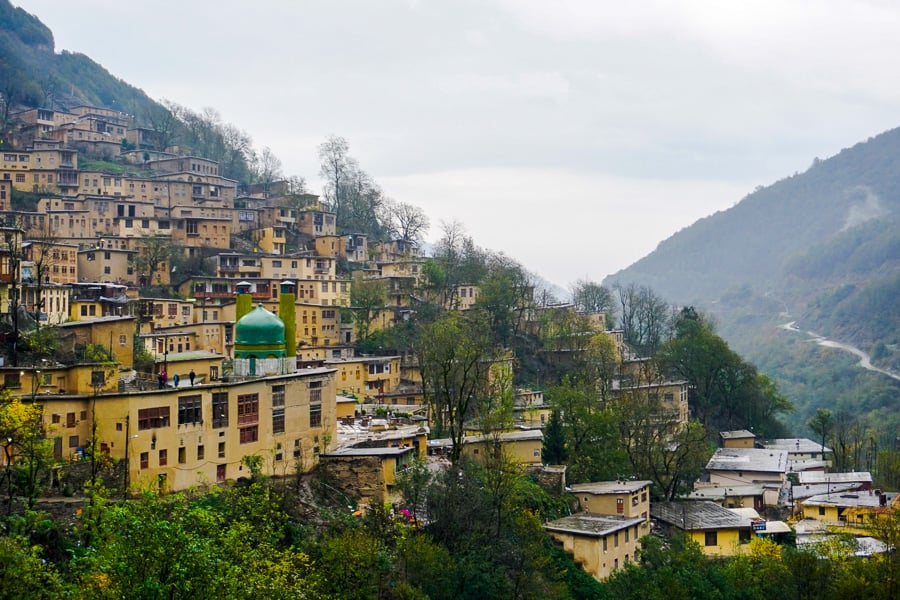
Qal’eh Rudkhan – Fortress In The Sky
Set aside the flat, parched Iranian desert landscapes you envisaged before your visit, because you might just find yourself thinking you’ve sidestepped into Europe as you hike into the chilly, lush green mountainscape surrounding Rudkhan Castle.
Guarding Iran’s Caspian Sea frontier against Arab invaders for more than a millennium, this haunting, well-preserved fortress is set high in the Alborz mountains. It remains an imposing sight today, with 1,500 metres of battlements and more than 40 towers.
On a wet day (and in winter) it’s a slippery hike up and down the mountain (Dan can attest to the fact after sliding right off the path and down a muddy slope), so be sure to wear decent footwear and take some time to enjoy the teahouses on the way.
Rudkhan Castle is about 90 minutes drive from Rasht. Enjoy a whole day exploring the area or combine it with a visit to Masuleh like we did. Entry to the trail was IRR150,000.
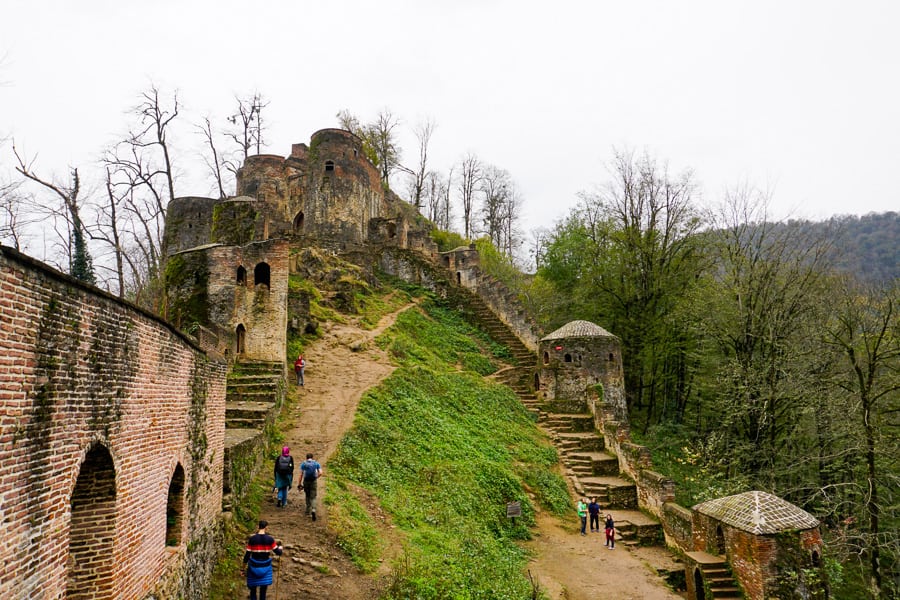
Central Iran Highlights
Naqsh-e Jahan Square, Esfahan – A Vast World Heritage Gathering Place
Nowhere is the majesty of Iran captured better than Esfahan. It’s already said by many to be the most beautiful city in all of Iran, and there are few spots in Esfahan more beautiful than Naqsh-e Jahan Square.
One of the largest public squares in the world (close to 90,000 square metres!), and home to some of the most ornate mosques and palaces in Iran, Naqsh-e Jahan is a focal point for life in Esfahan. It was a place we were repeatedly drawn to during our exploration of the city.
This is the place to embark on grand bazaar explorations, drink tea in magical tea houses (check out the quirky cool Azadegan Tea House off the square), marvel at breathtaking royal and religious architecture (see our separate entries below), and be regaled with the poetry of Hafez and Ferdowsi by enthusiastic young locals keen to share their culture and love of words.
Naqsh-e Jahan is beautiful during the day, but it’s even more stunning at night when the lights come on.
Random fact: The sport of polo originated in Persia some two thousand years ago. Keep an eye out for the marble goalposts marking Naqsh-e Jahan’s own early 17th-century royal polo field.

Jameh Mosque, Esfahan – An Ancient, Ever Changing Wonder
Reached via a meander through backstreets and the bustle of the Grand Bazaar, Iran’s oldest (and biggest) congregational mosque is a standout experience in a city packed with highlights.
Work started here in the 9th-century, and today Jameh Mosque is a World Heritage time capsule of architectural styles and dazzling geometric designs spanning more than 1,200 years.
We were captivated by the mosque’s tranquil hypostyle halls, elaborate brickwork (don’t miss the breathtaking Taj al-Molk dome), sublime light, and intricate tile work. This is a highlight of Esfahan and shouldn’t be missed.
Jameh Mosque is about two kilometres’ walk from Naqsh-e Jahan. It’s open every day but closed between 11am-1.15pm, and entry cost us IRR200,000 each.

Masjed-e Shah – Architectural Showcase & Peaceful Place Of Learning
Gracefully situated at the southern end of iconic Naqsh-e Jahan Square, Masjed-e Shah – the Shah Mosque – is yet another jewel in Esfahan’s crown and a must on any Iran tour.
Also known as the Royal or Imam mosque, this grand complex of intricate tiled mosaic passageways, niches, and vaulted chambers set around a large central courtyard and pool has been drawing visitors and pilgrims to Esfahan for more than 400 years.
While the 42-metre-high twin minarets and grand dome draw the eye the moment you enter the square, our own visit centred around appreciating the finer details, including the intricately designed entry portal, exquisite mihrab, beautifully crafted calligraphy, and the atmospheric main chamber.
Another real highlight for us was the opportunity to have a broad-ranging chat with a local mullah as part of the “friendly talks” program run by Madrasa Naseriyeh, a theological school located within the Masjed-e Shah complex.
Shah Mosque is open every day but closed between 11.30am-1pm, and Friday mornings. It cost us IRR200,000 each.
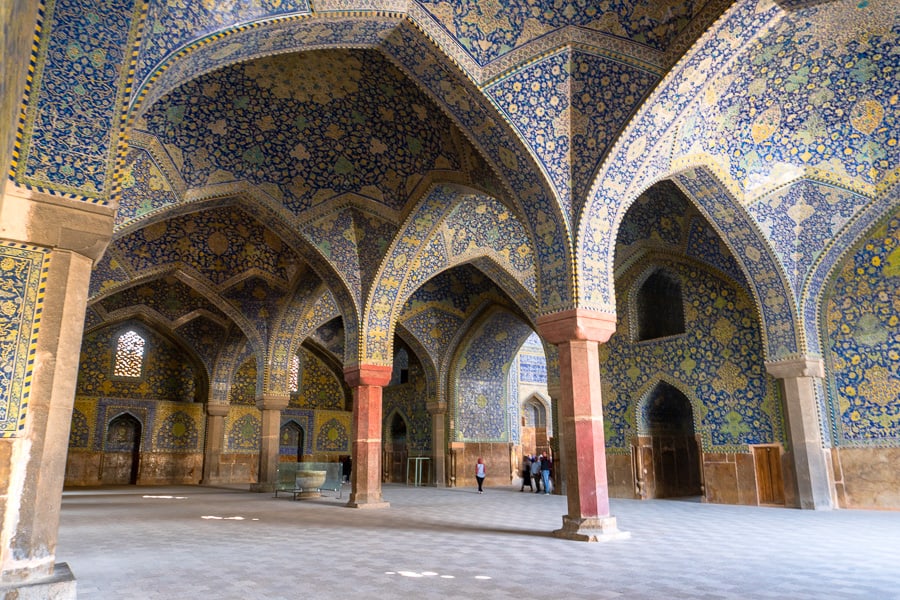
Masjed-e Sheikh Lotfollah – Sanctuary of the Sublime
Yet another structure vying for attention in Naqsh-e Jahan square is the 400-year-old Sheikh Lotfollah Mosque: a masterpiece in miniature, especially when the first and last light of day makes the golden dome glow.
You’ll feel the rising awe the moment you pass into the exquisite portal, entering a striking world of richly designed Safavid-era mosaics, finely carved decorative doorways, and sublime, shifting light.
If you’re anything like us, you’ll struggle to move on from the enchanting angled hallway, but when you eventually do, further reward awaits in the spectacularly tiled dome of the main prayer hall, with its beautiful latticed windows. Catch the light just right, and you’ll see the peacock at the dome’s heart, with its golden sunbeam tail. Photography is allowed, but be careful not to fall foul of the flash and tripod police; they’ll be watching.
Sheikh Lotfollah Mosque is open every day but closed between 12.30-2pm. The entrance fee when we visited was IRR200,000.

Chehel Sotoun, Esfahan – The Palace of 40 Columns
Built as a pleasure pavilion and reception hall using the Achaemenid-inspired columned porch style, Chehel Sotoun is reached via a terrace that perfectly bridges the Persian love of gardens and interior splendour.
In fact, the ambient grounds here have ensured the pavilion’s inclusion in the country’s collective World Heritage Persian Gardens listing.
While it may be slightly overshadowed by some of Esfahan’s better–known attractions, the palace, with its 20 ribbed wooden pillars rising to meet the beautiful inlay work of the wooden ceiling above, is well worth seeking out. There are vivid frescoes inside and, on the day we visited, a fabulously-bearded musician was plucking tunes among the columns on a traditional Persian tar.
Chehel Sotun means ‘40 pillars’, so if you’re wondering where the other 20 pillars are hiding, be sure to take a stroll around the long pool in front of the pavilion. If the waters are calm, you’ll see the pillars reflected, effectively doubling the number.
The pavilion is a ten-minute stroll west of Naqsh-e Jahan Square. It’s open every day and we paid an entry fee of IRR200,000 each.

Vank Cathedral – A Gilded, Frescoed Glory
With so many epic sights in Esfahan, it’s easy to understand how some visitors might not find their way to the Armenian quarter of Jolfa in the city’s south-west.
If time permits though, it’s absolutely worth making the stroll from the centre of Esfahan, across the striking Si O Seh Bridge over the Zayandeh River (see our separate entry below), to this pretty corner of the city.
Sixteen historic Armenian churches still stand in the quarter, the most important of which is the 350+ year old Vank Cathedral (the Church of St Joseph of Arimathea).
Approaching the modern-looking building (the outside was restored more recently), we were totally unprepared for what awaited inside. Not for the first time in Esfahan, we were completely mind-blown the moment we stepped through the doors. Every corner of wall and ceiling was covered in vivid, colourful paintings and gilded scenes from the Bible, a striking contrast alongside hand-painted tiles in the Iranian tradition.
The space inside Vank may be small; the impression it leaves is anything but.
Jolfa is also a great spot for people-watching in the evenings, so once you’ve extracted yourself from the churches, be sure to take a seat somewhere and watch the Armenian quarter come to life with young people gathering in the square and cafes to socialise. We also found the charming little Ani Café nearby, with excellent coffee and lovely staff.
Jolfa is around 4.5km from Naqsh-e Jahan Square and it took us around an hour to wander there. Vank Cathedral is open every day. Entry was IRR200,000 and we timed our arrival for late afternoon, and caught a beautiful sunset over the church.
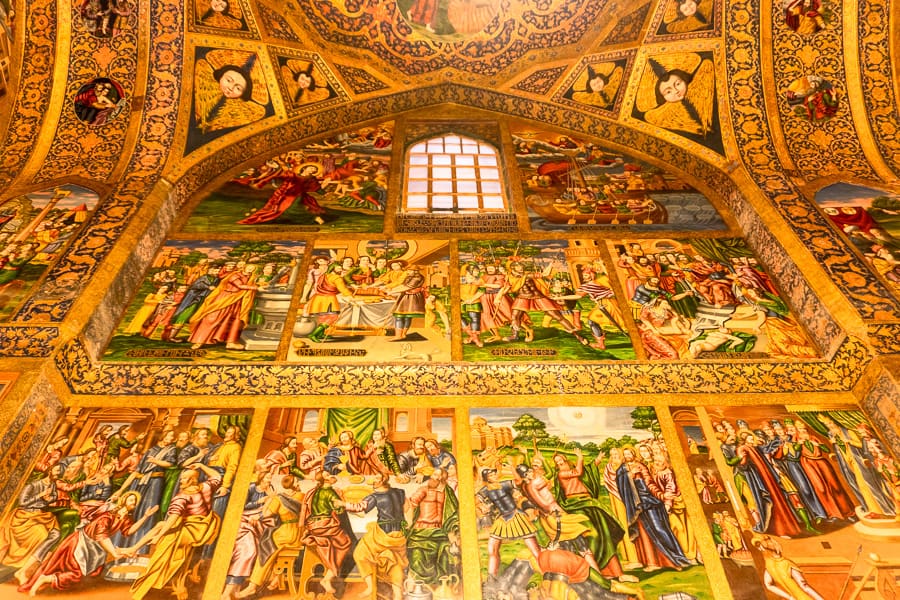
Si O Seh, Esfahan – The Bridge of 33 Arches
Elegant yet sturdy and more than four centuries old, Si O Seh is Esfahan’s picturesque, 33-span bridge. It’s especially photogenic at night, and the perfect place to end a day exploring this ancient city in central Iran.
Stretching almost 300-metres across the Zayandeh River (mostly a dry riverbed, as the water is usually drawn out upstream before reaching Esfahan), the bridge is a magic spot to hang out and people-watch, as local families take in the cooler evening air and groups of teenagers and young adults hang out among the spans. Keep an ear out for people singing under the arches.
We spent more than an hour here, wandering the archways, chatting with friendly locals, and pretty much snapping the bridge from every conceivable angle.

Ghoortan Citadel – Ghost of the Past
It’s no mean feat to move on from Esfahan; there’s just so much to see. If anything can tempt you away though, let it be an adventure in the desert to the south-east, and a trip to the beautiful Iranian interior around Varzaneh.
If you’re taxi’ing to Varzaneh as we did, chances are you’ll have the opportunity to stop and visit the thousand-year-old mud-brick fortress of Ghoortan Citadel. It rises from the flat, dry landscape on the edge of the desert.
This is a haunting, profoundly ambient place. Ghoortan Citadel may be crumbling with age, but a handful of resilient families still live here. We found wandering the silent, ancient maze of mostly abandoned laneways, houses, and thick protective walls and towers to be a truly extraordinary experience.
Ghoortan Citadel is around an hour and a half by taxi from Esfahan. We arranged to include a visit to the citadel with our driver on our ride from Esfahan to Varzaneh.

Desert of Varzaneh: Watch Sun Set from the Crest of a Giant Dune
Watching the day wind down atop a mountain of sand, looking out over the sunburnt desert of Varzaneh, is quite literally a high point on many an Iran itinerary, and for good reason!
This is one of the country’s more accessible deserts, and a popular gathering spot for families and young people as the heat of the day ebbs away in the late afternoon.
The dunes, among the highest in Iran, rise up suddenly from the flat, baked plains. Hiking the dunes is tougher than it might look, but once you get to the top you’ll be rewarded with sweeping views as the waves of sand are transformed into a burnt orange sea with the dropping sun.
We stopped at this beautiful spot after a memorable afternoon exploring the ancient, parched landscape of this region, where human history stretches back some 5,000 years. Afterwards, back at the base of the dunes, we snacked on watermelon and sipped tea as twilight fell over the desert. Magic.
We arranged our Iran desert tour through our guesthouse in Varzaneh, as part of a half day exploration of the highlights of the area. Trips vary, however we included in ours a stop at the photogenic Varzaneh salt lake and flats, sunset over the desert, and a spot of stargazing under brilliant, starry skies.

Stay in the desert-edge town of Varzaneh
To make the most of a visit to the desert and salt flats, consider staying a couple of nights in the small desert-edge town of Varzaneh.
This is a very quiet, low-key town, but the people are warm and welcoming, and a simple stroll here rewards with memorable scenes, like beautiful red roses blooming in dry, cracked garden beds; and ladies crossing the town’s arched bridge at sunset in billowing white chadors. This is the only place in Iran where the white chador is worn.
You’ll also see fine examples of the country’s famous pigeon towers here, both restored and crumbling with age. These circular towers were widely used to collect pigeon poo for use as a fertiliser in the parched landscape, before the advent of chemical fertiliser. They’re often beautifully decorated, eye-catching structures.
Yazd: City of Wind Towers
There’s plenty to like about the ancient desert city of Yazd, a destination recognised as World Heritage for its ancient and traditional adobe buildings, and clever underground water systems. For us though, Yazd is a standout for these things and more: it was here that we had the best Dizi in Iran.
Yazd has been welcoming Silk Road travellers for more than 1,500 years, and the sheer depth of history here is palpable as you walk the narrow laneways lined with earthen houses and shops.
This is a city to wander, to soak up the desert atmosphere, to get hopelessly lost in, to shed your city slicker worries, and immerse yourself completely in Persian history, culture and food.
There are plenty of highlights, but standouts include the Amir Chakhmaq Complex, with its beautiful archway symmetry; the Ateshkadeh Zoroastrian Fire Temple (Yazd was once a hub for the oldest monotheistic religion in the world); and the spectacular Jameh Mosque, with its soaring entryway, stunning tilework, and 48-metre-high minarets. We found the mosque’s ancient qanat open when we visited, deep underground down a steep staircase. We spent a while here, chatting with the very friendly locals.
Don’t Miss: Saheb A Zaman Zurkahneh
This unique, offbeat Iranian experience was a surprise highlight for us during our Yazd stay. Housed in a 440-year-old water reservoir, the zurkaneh is effectively a gym where men carry out an ancient tradition of exercises in sync using wooden clubs of different sizes.
There are strict rules and customs for participants, and the performance plays out to traditional music. If it sounds unusual, it is, but that’s exactly what makes it a must-see. The practice takes place each evening except Friday and entry cost us IRR200,000 each.
The perfect end to a day exploring Yazd is to find a rooftop late in the day (Check out the Art Café), drink some tea, enjoy the skyline dotted with tiled domes and wind catchers (very clever ancient systems that capture wind, cool it and send it around the home below), and generally just marvel at one of the world’s most ancient cities.
Then locate a Dizi house and eat your fill of this singular Iranian dish of lamb, potato and chickpea stew. This is a performance meal, not only in how it’s prepared and presented, but in how it’s eaten. Soooo good. Our fave spot in Yazd for Dizi, and other tasty local food, was Tormeh & Toranj.
Unsurprisingly, and perhaps like many other travellers for thousands of years – we found it very hard to leave this charming, ancient desert oasis.
We arranged through our guesthouse in Varzaneh to travel to Yazd by taxi, a journey of around two-and-a-half hours.
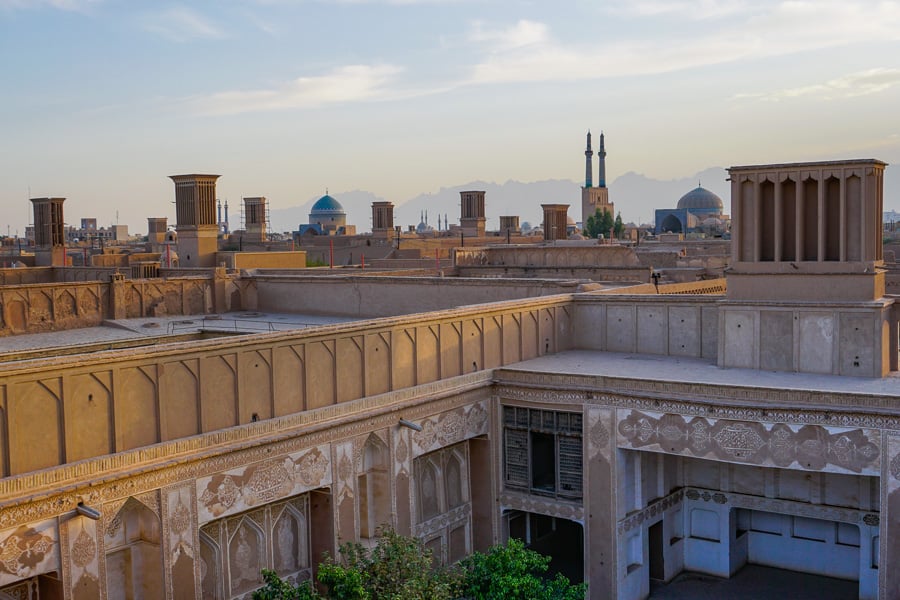
Kharanagh – Ancient Village Abandoned Not Forgotten
80 kilometres from Yazd, overlooking a peaceful scene of farms backed by dry, rugged mountains, is the captivating village of Kharanagh: totally ambient and, for all intents and purposes, totally abandoned.
Believed to have been settled by the Zoroastrians more than a thousand years ago, this intriguing town of winding passageways and mud brick houses is a treat to explore.
While there are plenty of signs the surrounding lands are actively farmed, we came across more animals than people on our exploration of the silent, crumbling town. Still, it wasn’t difficult to imagine a time when families filled the adobe rooms, the call to prayer rang out from the still-standing minaret, and life bustled within the narrow laneways.
As we parked up on a patchy rooftop and looked out over the ruins, we had the distinct feeling that, while ancient Kharanagh is slowly eroding away, it’s story will carry on long after it’s gone.
We visited Kharanagh on a daytrip from Yazd, taking in this site as well as the Zoroastrian Fire Temple at Chak Chak (see our entry below), and hulking Narin Castle in the city of Meybod. Travelling with two others, a taxi and driver for the day cost us around IRR 1.7 million, plus entry fees. Entry to Karanagh was IRR50,000 each.

Pir-e-Sabz (Chak Chak) Fire Temple – An Ancient Mountain Shrine
From the moment we started researching our Iran trip, we were intrigued by Zoroastrianism and the mysterious fire temples where this ancient Persian religion was practiced.
Yazd was a centre of Zoroastrianism (it still has a significant population of followers), and Chak Chak, a fire temple halfway up a sheer mountain, is an excellent place to get familiar with the world’s oldest monotheistic religion.
Legends swirl about this ancient place. One says the drops of spring water at Chak Chak are the mountain’s tears for the daughter of a Sassanid ruler, who was trapped here by the invading Arab army in the seventh century. Desperate, the princess prayed for help and the mountain opened up to offer her refuge.
The fire temple is located in a cavern at the top of more than 200 heart-pumping steps. Given its importance as a pilgrimage site, the temple itself is a surprisingly small and understated space centred around an eternal flame, and accessed through impressive bronze doors imprinted with the religion’s founder, Zoroaster.
The levels above and around the temple are rooms set aside for the thousands of pilgrims who make their way to the temple for a Zoroastrian festival in June each year (it’s closed to other visitors during the festival so check ahead if you’re travelling around this time).
For us, the visit was memorable for the simple, peaceful ambience of the fire temple and the rugged beauty of the surrounding landscape. Be sure to allow time to really take in the setting, and enjoy the stunning views from the high terraces.
We visited Chak Chak as part of a day trip from Yazd, also visiting Kharanagh (see our entry above) and the city of Meybod. Entry to Chak Chak was IRR50,000 each.
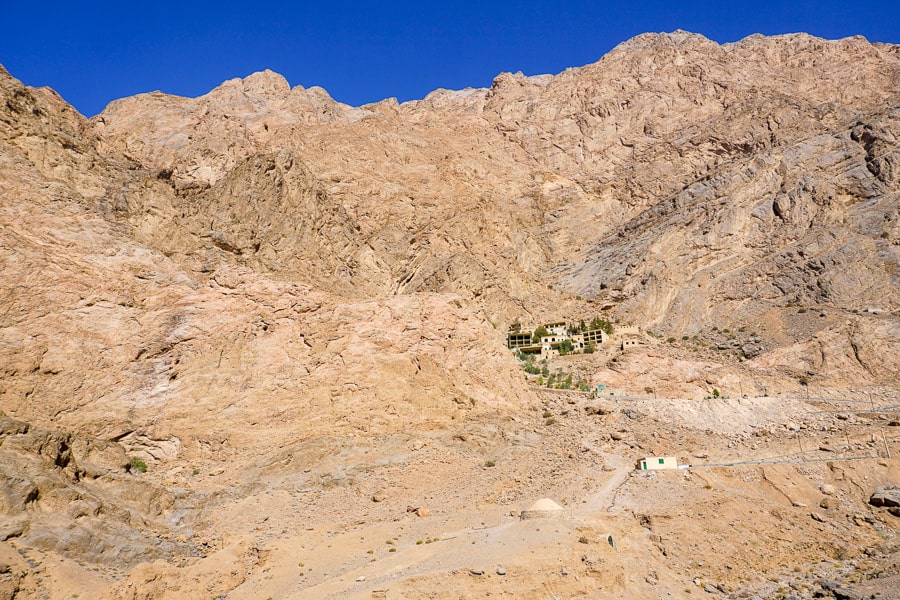
Southern Iran Highlights
Naqsh-e Rustam – Necropolis of Legendary Kings
A journey into Southern Iran takes you deep into Persian history, to the ancient Achaemenid Empire and an age of celebrated Persian kings like Cyrus, Darius and Xerxes.
These are giants of human history, leaders that shaped the ancient world. They are, quite literally, the stuff of song and legend.
You can find this epic history carved into the cliff-face at Naqsh-e Rustam, the necropolis of Persia’s legendary kings Darius the Great, Xerxes the Great, Ataxerxes and Darius II.
We were rendered speechless as we stood facing these powerful and ancient mausoleums for four members of the dynasty that founded the first Persian Empire: their stories chiselled into the stone by real people in the distant past. For history buffs like us, travelling doesn’t get much better than this.
We incorporated our visit to Naqsh-e Rustam into our taxi ride from Yazd to Shiraz. Building it into our journey (which we shared with two others) was more time and cost effective for all of us, and meant we could dedicate more time the following day to exploring the ancient city of Persepolis. Entry to Naqsh-e Rustam was IRR 200,000 each.

Pasargadae – Monument to the Founder of the Persian Empire
Another of Iran’s impressive World Heritage sites, Pasargadae was once the capital of the Achaemenid Empire and lies on a large archaeological site around 90 minutes’ drive northeast of Shiraz.
If we’re honest, this highlight might be more for history nerds like us, since you need a fair amount of imagination (and energy) to bring the mostly ruined site to life as you wander the complex in the blazing desert sun.
For us, the stately tiered limestone tomb of Cyrus The Great, founder of the First Persian Empire, was the highlight of our visit, and provides a sense of the grandeur befitting the site. Cyrus, the second of his name, ruled from 559-530BC, conquering and expanding to create the world’s largest empire up to that point.
There’s some suggestion his mausoleum was restored in the year 324BC on the orders of Alexander the Great, who found the tomb already ransacked.
The rest of the site is made up of seemingly random ruins and stones which actually form up the floorplans of palaces, gardens and a citadel. There’s also an unusual tall building similar to one at Naqsh-e Rustam, evocatively called Solomon’s Prison. It was once thought to be a fire temple, among other things; no one’s really sure.
While it’s easy to visit Pasargadae and Naqsh-e Rustam along with Persepolis on a day trip from Shiraz, we decided to build in stops at Pasargadae and Naqsh-e Rustam on our journey from Yazd to Shiraz for the reasons outlined in our entry above. Entry to Pasargadae was IRR200,000 each.
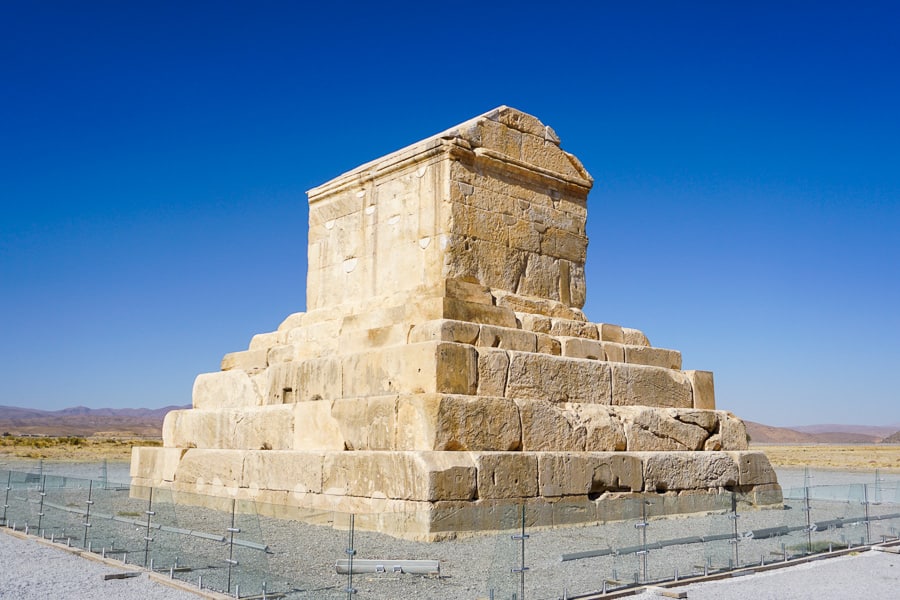
Persepolis – Ancient City of Kings
Almost certainly one of our favourite places to visit in Iran (and one of the longest-standing entries on Dan’s lifetime bucket list of ancient places), the World Heritage site of Persepolis stands as a timeless testament to the powerful past of the Persian Empire, and the deep foundations of Iran’s present.
Started by Darius the Great in the 6th century BC, Persepolis was the ceremonial capital of the Achaemenid Empire. It thrived for nearly 200 years, until Alexander the Great turned up with his army in 330BC. After sampling the luxuries of the palaces, he looted and burnt them down. Not one of his ‘great’ moments.
Two millennia on though, and despite the scattered masonry and ruins, there’s still plenty to see here, starting at Xerxes’ epic Gate of All Nations, surely the inspiration for the Sphinx Gate in ‘The Neverending Story’!
Persepolis is an absorbing complex of columned palaces, halls and cliff-carved tombs. Keep an eye out for the details around the site, like the double-sided bull capitals on the columns (and the ground in places, where they offer serious perspective on their size).
The beautiful wall reliefs on the Apadana Staircase are a showstopper, offering intricate details on the cultures coming to Persepolis from all over the region at the time. They look like they were carved yesterday, thanks to centuries buried in the desert sand.
If you can, don’t miss the opportunity to be at Persepolis for sunset. Watching the sun drop beyond the site, just as it has for more than 2,500 years, was a highlight for us (our banner pic for this post was taken at sunset at the Gate of All Nations).
Definitely go with a guide to get the most out of your tour, and make sure you ask for extra time to wander at leisure, and seek out the exquisite detail that makes this one of the world’s must-see ancient sites.
Persepolis is around 50km northeast of Shiraz. Entry was IRR200,000 each. We organised our excellent guide and driver through Mr Persepolis – email us for more info. For security reasons, backpacks aren’t usually allowed in and there’s a security check at the entrance. To be on the safe side, we’ve heard smaller, single strap shoulder bags are usually ok but check with your guide before going.
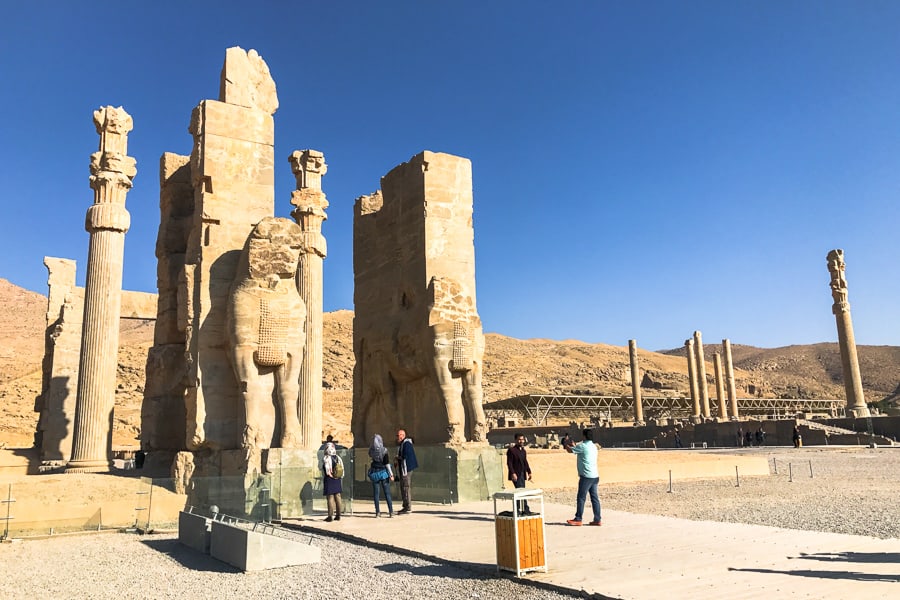
Masjid Nasir ol-Molk – The Exquisite Pink Mosque of Shiraz
Probably one of the most photographed spots in all Iran, a visit to beautiful Nasir ol-Molk is equal parts wonder and exasperation, but should absolutely enjoy ‘must visit’ status on your Iran itinerary.
Every morning the ornately columned prayer hall of Shiraz’s Pink Mosque erupts into a riot of kaleidoscopic colour as the first light of day streams in through its stained glass windows.
Be there for opening and you may be rewarded with a few peaceful moments before the tour groups arrive, at which point photography etiquette disappears completely in a chaotic, oblivious swirl of people, all determined to capture the moment from every possible angle.
That’s the point we decided to find a spot out of the way at the side of the room and just enjoy the morning light dancing across the intricate painted tiles, carved pillars and beautiful hand-woven Persian carpets.
Be sure to wander to the other areas of the mosque too: the painted tilework in the archway opposite the prayer hall is delicate and beautiful.
Nasir ol-Molk is in the heart of Shiraz. Check the time of sunrise when you visit and the opening hours of the mosque. Entry was IRR 200,000 each.

Tomb of Hafez: A Love Letter To Iranian Poetry
Spend any time in Iran and you’ll quickly realise that poetry is a serious business here. It enjoys a central and time-honoured place in Iranian life and cultural identity.
While we may fall back on the snippets of Shakespeare we were forced to learn at school, the Iranians we met happily regaled us with beautiful verses from their favourite poets.
We’ve got fond memories of one young guy quoting us passages of Hafez – perhaps Iran’s most revered poet – in Esfahan’s main square, without any of the self-consciousness that might accompany such an act back home.
Hafez lived in Shiraz in the 14th century, and if you’re visiting the city, one of the best places to appreciate Iran’s love of poetry is at his resting place, the Tomb of Hafez. Families, couples and friends gather here in the pretty gardens, and you’ll find excerpts of his timeless poetry inscribed on the tomb and around the site.
“Even after all this time, the sun never says to the Earth, ‘you owe me.’ Look what happens with a love like that! It lights up the whole sky.”Hafez
We recommend visiting the tranquil gardens later in the day as the sun drops. Entry was IRR200,000 each.
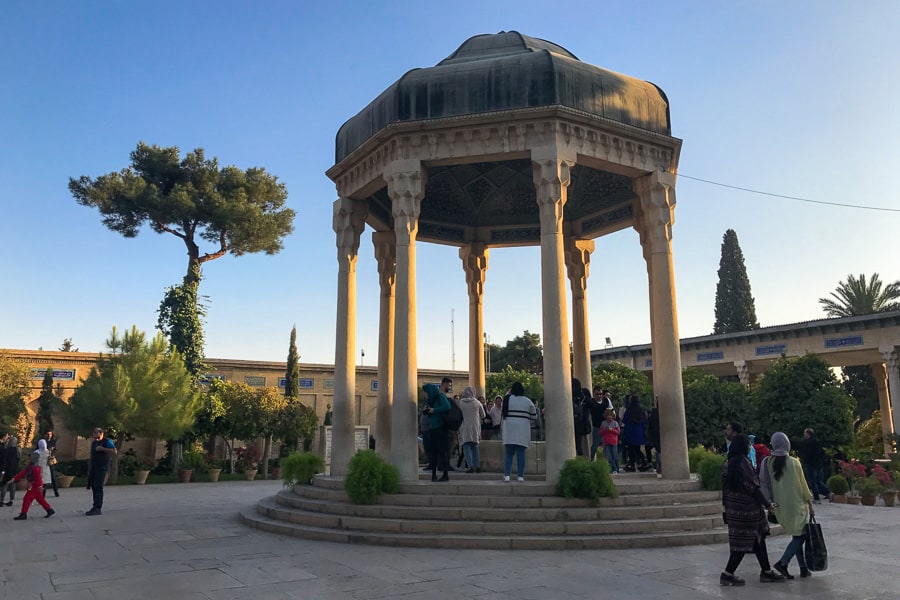
Bishapur and Shapur Cave: Where Empires Collide
If ancient empires get your engines running like they do ours, and if you have a spare day in Shiraz, then consider a day trip to Bishapur, two hours to the northwest of Shiraz. The drive from Shiraz to Bishapur is a delight in itself, passing through dramatic mountain and canyon country.
Bisahpur was the seat of Sassanian King Shapur I, who ruled the Persian Empire from around 240 to 270 AD. He went head to head with the Roman Empire, taking their cities, allegedly killing one Roman Emperor (Gordian III), signing a peace treaty with a second (Philip I), and taking a third prisoner (Valerian), along with his army.
These war stories are detailed in vast carvings along the wall of the Chogan Gorge, near the ancient city, itself built by Roman captives.
We found the detailed reliefs completely absorbing, and a good thing too, as it turned out the city ruins were unexpectedly closed on the day we visited.
Our awesome guide Cyrus instead found a path for us above the hill opposite the city, where we could look down on the ruins while he explained the history of the site. There’s still much to be excavated, but archaeologists have so far uncovered a palace, temple, monumental columns and beautiful mosaics.
From the hill above Bishapur, we made our way to the base of a huge escarpment, and began a sweaty, 90 minute climb to a cave hidden in the rockface above. There, overlooking a spectacular mountain-and-valley vista, the cave hosts a monumental statue of King Shapur I, carved from a single block of limestone.
Time, earthquakes, and poor restoration efforts have stolen some of the statue’s command, but it’s still a sight. Better yet, the vast, dark cave behind delivers outstanding acoustics, a fact we discovered when a single voice rang out from the dark in beautiful plaintive song, courtesy of the small group ahead of us.
We day tripped to Bishapur, Chogan Gorge and Shapur I Cave in the company of a Shiraz guide/driver that was recommended to us by other travellers. Drop us a line if you’d like the details of our guide, Cyrus.
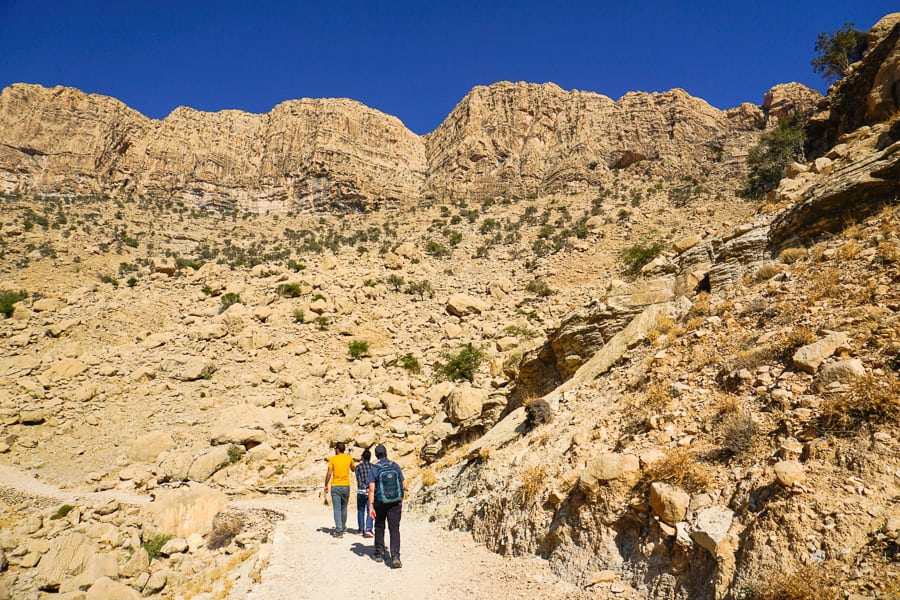
Highlights of Western Iran
Shushtar Historical Hydraulic System – A Marvel of Ancient Engineering
The best way to appreciate the sheer scale and engineering smarts of Shushtar’s incredible World Heritage-listed historical hydraulic system is to grab a perch at a clifftop café, order some tea (and a water pipe if you’re into hubbly bubbly), and enjoy the view. It’s especially beautiful after dark when it’s all lit up.
The Sassanian-era structures you see today, said to have been built by the captive Roman emperor Valerian and his enslaved army, have been diverting water from the Karun River for irrigation and water mills since around the 3rd century. But the people here have been mastering the river and changing the face of this desert landscape to support farming and planting for far longer, since the time of Darius the Great.
In addition to the canals, bridges, mills and cascades you can see at the historical hydraulic complex (which is still operating today), there are sturdy, functioning weirs and dams along the river that showcase the ancient and lasting engineering skill of the Persians.
It’s worth getting down to street level at the hydraulic complex and taking a stroll through the system with the sound of water thundering in your ears while you get up close and personal with the ancient watermills that dot the site.
We travelled to Shushtar by bus from Shiraz, first making our way by overnight bus to the city of Ahvaz, then taking a taxi from the intercity bus station to Istgah Station, where we boarded a local bus to Shushtar. The total cost was around IRR 630,000 each. Entry to the historic hydraulic system was IRR 200,000 each.
Food Highlight: If you’re staying in Shushtar, be sure to hit up Ferouzdizi for a delicious, beautifully presented meal of Iranian specialty, Dizi.

Choqa Zanbil Ziggurat – The Temple Complex Defying Time
To visit Choqa Zanbil Ziggurat is to travel even further back into ancient Iran, to the period before the rise of the Persian Empire. This huge terraced, pyramid-like structure, dates from the time of the ancient Elamites.
Rising out of the desert like a vast, monolithic mirage, Choqa Zanbil Ziggurat has dominated the dusty landscape of Khuzestan province in southwest Iran for more than three millennia.
This ancient complex of tiered walls, squares, rooms and temples, yet another UNESCO gem, stands out from the crowd in a region teeming with World Heritage sites. More than a hundred meters long on each side, and originally five stories high, the well-preserved brick structure is thought to have once been capped with an über sacred Elamite temple.
We visited the ziggurat in the high heat of the mid-afternoon. With hindsight, we’d look to make it a later visit, both to avoid the heat and the glare. Still, Choqa Zanbil’s scale – in both size and history – make it an amazing sight at any time of day. Moreso when you discover the parched landscape in which it sits was once lush and green. Not easy to imagine.
Keep an eye out for the small details, like the line of bricks running around the entire structure covered in ancient cuneiform script. Also look out for the small footprint preserved in the clay by the sundial in the courtyard paving; how it got there is anyone’s guess but, surrounded as it is by enduring brick and pavement, it’s a compelling human link to a very distant past.
Choqa Zanbil Ziggurat is around 45 minutes’ drive from Shushtar. We highly recommend visiting the ziggurat – and other local attractions like the World Heritage ruins of Shush (Susa) – with a guide, to ensure you get the most out of this very ancient corner of Iran. Drop us a line if you’d like the details for our lovely guide, Mehran. Entry to the ziggurat cost us IRR200,000 each.
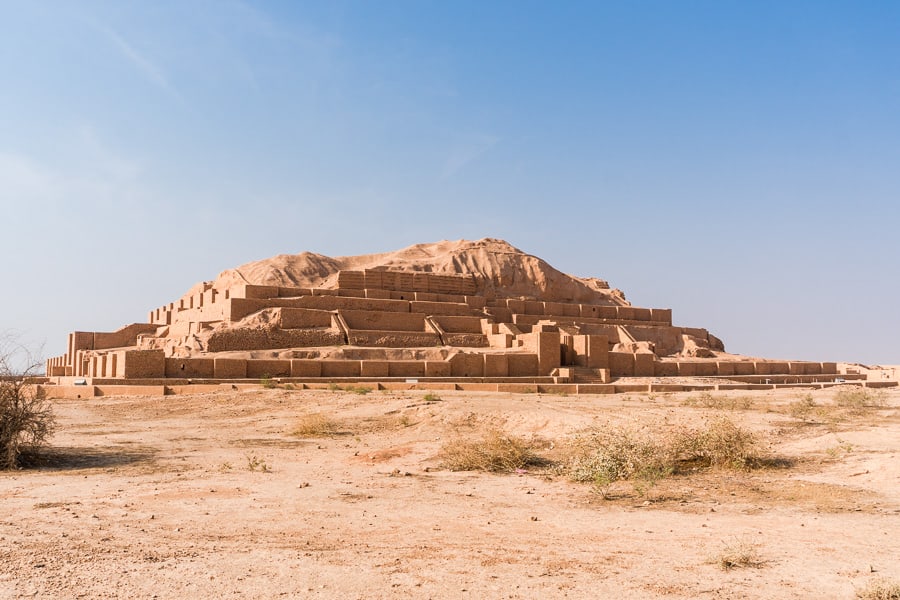
Have you visited Iran? What would you add to this list? We’d love to hear about your personal favourite things to do in Iran below, or ask us any questions you might have!

Hello, I am a 14-year-old Iranian girl, and I was very happy to see that the people of European and American countries, with all the beauty and charm of their own country, love our country. I am really happy that people from foreign countries come to our country and praise the hospitality of our country. I really like your name. John and Daniel are my favorite names. I hope you have a pleasant trip.
Hi Ariatis, thank you for your message. We very much enjoyed our travels in Iran – your country is very beautiful and we met so many kind and friendly people. All the best!
Hormoz Island, gheshm island,Darak beach, Tehran country side like Fasham &lavasan
Thanks Melika
Great suggestions, wish we’d have had time to get to some of those spots.
Still, it’s always good to have a reason to go back.
All the best.
John and Danielle